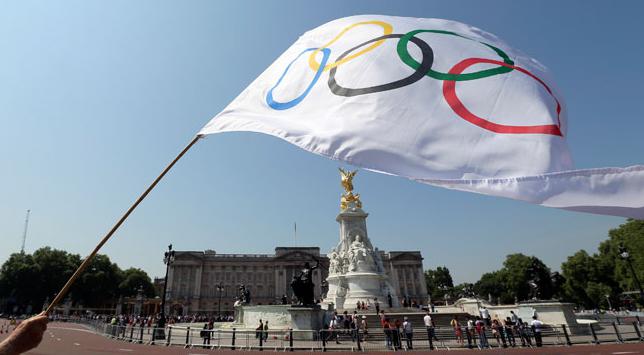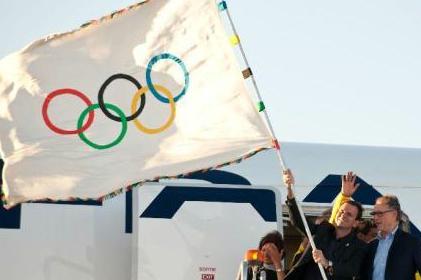Olympic flag - what does it symbolize?
The beginning of the Olympic Games was laid in southern Greece in the city of Olympia. The original game program included a one-stage run. Further, the program began to be supplemented with new types of competitions: running for two stages, for 24, with weapons. Then pentathlon, chariot racing, fisticuffs and wrestling were added.
The reward for the winner was an olive branch, and the inhabitants of the city, whose representative was the champion, presented him with gifts, provided a place in the theater for free, and exempted him from taxes.
These traditions of the Olympic Games have been preserved for eleven centuries. After that, a change in the content and nature of the competition began to be traced.
Antiquity ceased to exist. This happened due to a change in worldview and the dominant religion.
Now the Olympic Games are not just a competition of athletes. Holding this event in your country is a huge prestige both for the state itself and for its president.
Currently, the competitions are not complete without certain symbols - this is a mandatory attribute of the games (Olympic flag, medals, anthem, fire, oath, slogan, talismans, emblem and salute).
Olympic Games logo
The official logo of the Olympics are five rings intertwined. It was created by the founder of the competition, Baron Pierre de Coubertin in 1913. This is the main version of the creation of the Olympic flag. Initially, the colors of the rings were not symbols of any of the continents or states. This came much later. Five rings began to symbolize the number of continents: Australia (green), America (red), Asia (yellow). Europe is blue and Africa is black. The sixth continent - Antarctica - was not taken into account for some reason. The flag of any state has at least one of the colors present on the rings. The Olympic flag includes a logo with five rings presented in the corresponding color. 
The second version of the creation of the flag
Here is another version of what the Olympic flag symbolizes. She is very original. This is the creation of psychologist Carl Jung. Being a supporter of Chinese philosophy, Carl Jung personified rings with vitality, grandeur and energy. The beliefs of the Chinese speak of the control of the world by five energies: earth, fire, water, metal and wood. Jung combined these symbols into five rings. At the same time, sports (according to Jung) also had their own colors. Swimming - blue, fencing - red, running - yellow, jumping - green, shooting - black. He was convinced that each of the athletes should master all five sports.
Now the Olympic flag symbolizes not five sports, not five energies, but five continents.
Flag of the Olympics
The flag was raised for the first time in 1914 in the capital of France, but not at the Olympic Games, but to celebrate the 20th anniversary of the revival of these competitions. For the first time, it was planned to use the Olympic flag at the games in 1916. Because of the war, the competition did not take place, and the banner was not presented to the public. At the beginning of the twentieth century (in Belgium) the seventh long-awaited Olympic Games took place. For the first time, a flag with the logo of these competitions was presented on them. All the opening and closing ceremonies of the competitions in question are not complete without the rings of the five continents, which symbolizes the flag of the Olympic Games. 
Olympic flag definitions
To date, one of the paragraphs summarizes the definitions of concepts: symbol, motto and emblem of the games.
The motto expressing the desire for it sounds like this: “Faster, higher, stronger!” It was this phrase that was uttered by the French priest Henri Didon and was later taken as a motto by the founders of the games.
The Olympic emblem is a combination of rings and other distinctive signs. It is familiar to almost everyone.
The Olympic symbol is the rings used in multi-color or solid colors. 
What does the Olympic flag look like?
The Olympic banner looks like a white canvas with a gold border, in the center of which there are five interlaced rings. The Olympic Games symbolizes peace during their holding. Thanks to this color, all the rings on the banner look more correct and without distortion. Looking from left to right, the first ring on the flag is blue, then yellow, black, green and red. Closest to the flagpole is the blue circle.
The rings are the unity of the five continents, which symbolizes the Olympic flag. We have already talked about this.
The banner, motto, symbol and emblem are the property of the International Olympic Committee.
Banner at the opening and closing ceremonies of the Olympic Games
What role does it play? The opening of the Olympic Games begins with the raising of the flagpole of the stadium without the gold border of the Olympic flag. The banner is made by the country that holds competitions on its territory. At the time of closing, the country in which the competitions were held hands over the Olympic flag to the state in which they are planned to be held in four years. But it already has a golden border. 
Other game symbols
The Olympic flame, as one of the significant and important symbols of the competitions in question, is lit from a parabolic mirror in Greece. Then, from one athlete to another, the fire is transferred and swept across all five continents. On the opening day of the Olympics, the torch is passed to the venue, which symbolizes the beginning of the games.
The host country chooses the mascot of the Olympics at its discretion. It has always been so. Usually the mascot is an animal. Where did this symbol come from? The talisman was born not so long ago - in 1968. And in 1972 in Munich, Waldi the dachshund was recognized as the first official mascot.
The motto of the Olympics is the Latin words - "Citius, Altius, Fortius" ("Faster, Higher, Stronger").
Of gold, silver and bronze are awarded to athletes who won the competition. If this is a team sport, then each member of the team receives medals. The competition organizers themselves develop their own unique design of awards.
The anthem of the Olympic Games (sounds during their opening and closing) was written by a Greek composer. Many sports fans and adherents of a healthy lifestyle have also already heard it.
The Oath of the Olympics was written by Pierre Coubertin. Later it was slightly changed.
The olive branch means a symbol of calm and truce, and the Olympic salute warns of the closure of the competition.
Competition emblems symbolize different types of competitions. For example, a skier personifies skiing sports.
Why do we need symbols in competitions
Traditions, expressed in symbols, help to feel the importance and significance of the ongoing Olympics, the unity of all countries. And that means all five continents. 
The Olympic Games that are currently taking place are saturated with symbols and traditions. During them, many viewers closely follow the impressive spectacle, the success of the athletes or teams they support. However, at the end of the 19th century there were much fewer Olympic attributes. Now the number of various characters is only increasing. Their main goal is to promote the Olympic Games.
In addition to the main one, there is another version of the creation of so many symbols - this is a source of income for the organizing committee. Therefore, the number of products sold from games is only increasing. Now we know what the Olympic flag and other symbols of the competition look like.














